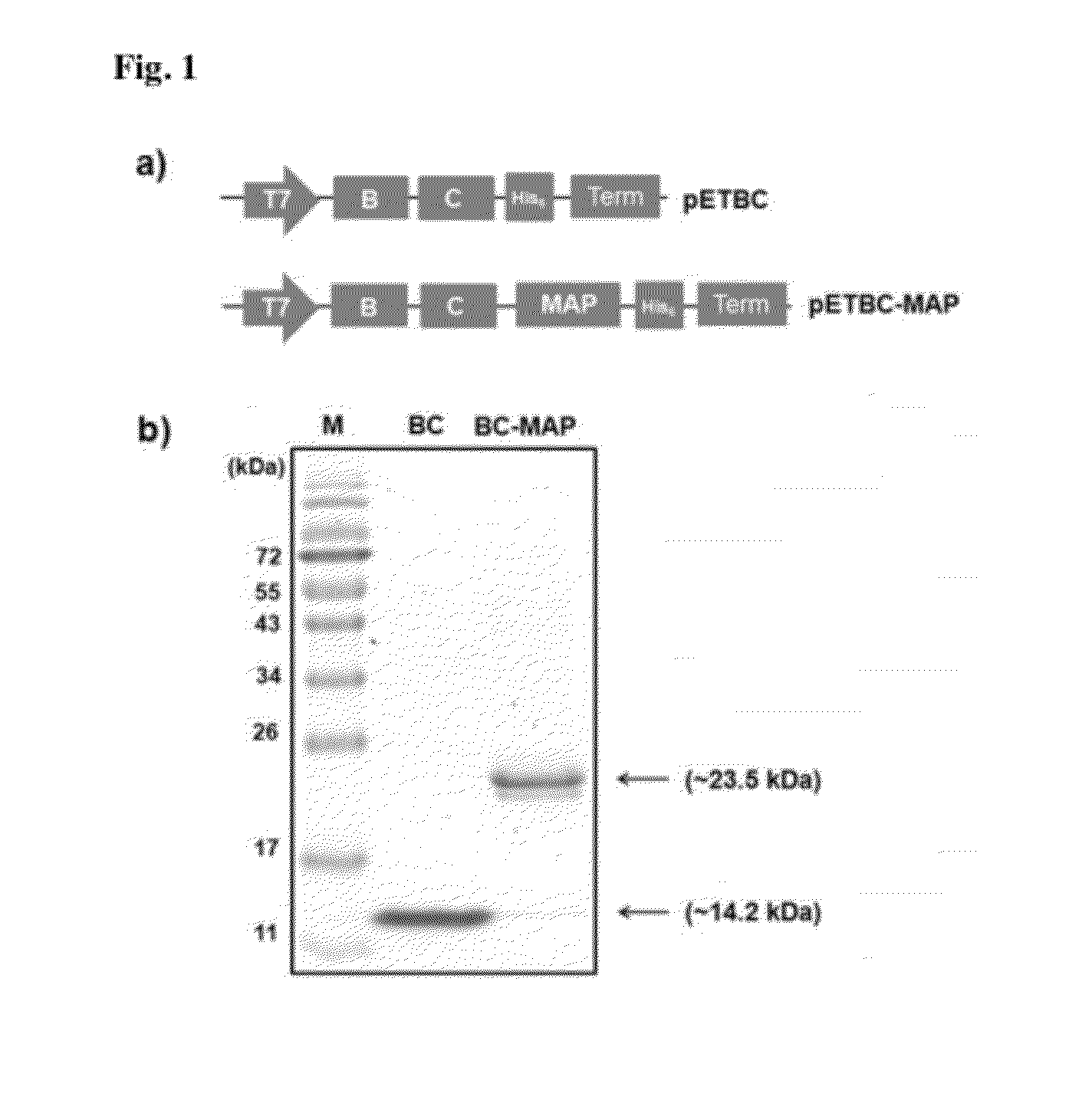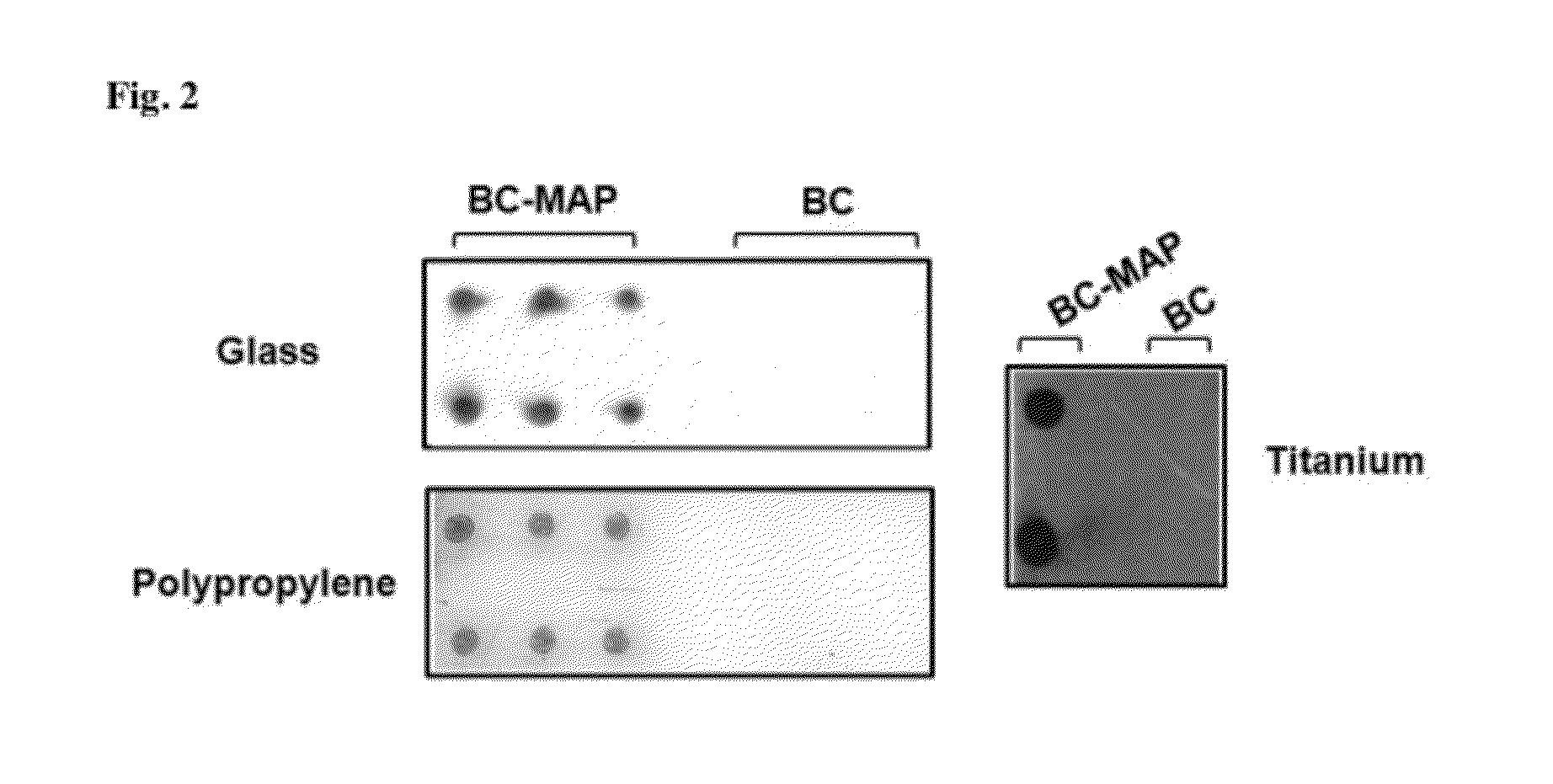Novel immobilizing fusion protein for effective and oriented immobilization of antibody on surfaces
a fusion protein and surface antibody technology, applied in the field of fusion proteins, can solve the problems of reduced antibody activity, antigen binding ability, and large difficulty in efficient attachment of antibody-binding proteins to solid surfaces, and achieve the effect of improving antibody binding ability and adhesion efficiency
- Summary
- Abstract
- Description
- Claims
- Application Information
AI Technical Summary
Benefits of technology
Problems solved by technology
Method used
Image
Examples
example 1
Construction of Expression Vectors
[0084]1.1: Construction of Expression Vector for BC-MAP Fusion Protein
[0085]The gene coding of MAP fp-5 was amplified by a polymerase chain reaction (PCR) from the previously constructed vector pMDG05. The forward primer (F1: 5′-GGGCCCATGGGGTGGCGGAGGGAGCTCTGAAGAATATAAAG-3′, SEQ ID No:1) was designed to contain a NcoI restriction enzyme site and the sequence encoding a GGGG amino acid linker. The backward primer (B1: 5′-CGCGCTCGAGGCTGCTGCCGCCATAATATTTTTTATAG-3′, SEQ ID No:2) was designed to contain a XhoI restriction enzyme site. The PCR product was digested with two restriction enzymes of NcoI and XhoI (Fermentas, Burlington, Ontario, Canada). The digested DNA fragment was ligated with a pET22b(+) vector (Novagen, San Diego, Calif., USA), which predigested with NcoI and XhoI, by using a ligation kit (TaKaRa, Shiga, Japan) to make the plasmid pET-MAP. The gene, encoding two domains (B and C domain) of protein A, was amplified by PCR from the genomic ...
example 2
Expression and Purification of BC-MAP and Sole BC Proteins
[0088]Each plasmid containing pET-BC-MAP or pET-BC was transformed into Escherichia coli BL21 (DE3). The transformants were grown to 0.8-0.9 OD600 at 37° C. in shake flasks containing of 400 mL of Luria-Bertani (LB) medium (0.5% yeast extract, 1% tryptophan, and 1% NaCl) with 50 μg mL−1 ampicillin. The expression was induced by adding isopropyl β-D-thiogalactopyranoside (IPTG) to a final concentration of 1 mM. The transformed cells were grown for an additional 10 h at 37° C. The cells were harvested by centrifugation at 4000 g for 10 min. The cell pellets were resuspended in lysis buffer (50 mM NaH2PO4, 300 mM NaCl, 10 mM imidazole, pH 8.0) and disrupted with a sonic dismembrator (Fisher scientific, USA) for 10 min at 50% power (3 sec pulse on and 2 sec pulse off). The soluble and insoluble fractions were then separated by centrifugation at 9000 g for 30 min at 4° C. The soluble fractions were loaded into a Ni-NTA column (Qia...
example 3
MALDI-TOF MS Analysis
[0089]Matrix-assisted laser desorption ionization mass spectrometry with time-of-flight (MALDI-TOF MS) analysis was performed on a 4700 Proteomics Analyzer (AB Sciex) in the positive ion linear mode. A-cyano-4-hydroxycinnamic acid in 50% acetonitrile and 0.1% trifluoroacetic acid was used as the matrix solution. Sample were diluted 1:20 with matrix solution, and 1 μL of the mixture was spotted onto the MALDI sample target plates and evaporated using a vacuum pump. Spectra were obtained in the mass range between 5,000 and 25,000 Da with ˜2000 laser shots. Internal calibration was performed using mix 3 of sequazyme peptide mass standard kit (AB Sciex).
PUM
| Property | Measurement | Unit |
|---|---|---|
| flow rate | aaaaa | aaaaa |
| flow rate | aaaaa | aaaaa |
| pH | aaaaa | aaaaa |
Abstract
Description
Claims
Application Information
 Login to View More
Login to View More - R&D
- Intellectual Property
- Life Sciences
- Materials
- Tech Scout
- Unparalleled Data Quality
- Higher Quality Content
- 60% Fewer Hallucinations
Browse by: Latest US Patents, China's latest patents, Technical Efficacy Thesaurus, Application Domain, Technology Topic, Popular Technical Reports.
© 2025 PatSnap. All rights reserved.Legal|Privacy policy|Modern Slavery Act Transparency Statement|Sitemap|About US| Contact US: help@patsnap.com



